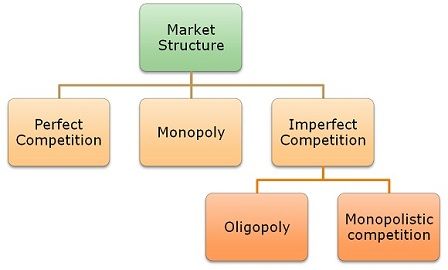 The term market can be described as any place where buyers and sellers meet, directly or through dealers, to conclude transactions. There are three types of market structure, i.e. perfect competition, monopoly and imperfect competition. Further imperfect competition can be of two types: Monopolistic competition and oligopoly. In perfect competition, the product sold by different firms is identical, but in monopolistic competition, the firms sold near substitute products.
The term market can be described as any place where buyers and sellers meet, directly or through dealers, to conclude transactions. There are three types of market structure, i.e. perfect competition, monopoly and imperfect competition. Further imperfect competition can be of two types: Monopolistic competition and oligopoly. In perfect competition, the product sold by different firms is identical, but in monopolistic competition, the firms sold near substitute products.
The equilibrium position of these market are reached in different circumstances and are based on revenues earned and cost incurred. In the article provided to you, we’ve simplified the differences between perfect competition and monopolistic competition.
Content: Perfect Competition Vs Monopolistic Competition
Comparison Chart
| Basis for Comparison | Perfect Competition | Monopolistic Competition |
|---|---|---|
| Meaning | A market structure, where there are many sellers selling similar goods to the buyers, is perfect competition. | Monopolistic Competition is a market structure, where there are numerous sellers, selling close substitute goods to the buyers. |
| Product | Standardized | Differentiated |
| Price | Determined by demand and supply forces, for the whole industry. | Every firm offer products to customers at its own price. |
| Entry and Exit | No barrier | Few barriers |
| Demand Curve slope | Horizontal, perfectly elastic. | Downward sloping, relatively elastic. |
| Relation between AR and MR | AR = MR | AR > MR |
| Situation | Unrealistic | Realistic |
Definition of Perfect Competition
The market structure in which there are numerous sellers in the market, offering similar goods that are produced using a standard method and each firm has complete information regarding the market and price, is known as a perfectly competitive market. The entry and exit to such a market are free. It is a theoretical situation of the market, where the competition is at its peak.
The firms are price takers in this market structure, and so, they do not have their own pricing policy. The individual buyers and sellers have no control over the prices. Therefore, the sellers have to accept the price ascertained by the demand and supply forces of the market and sell the product, as much as they can at the price prevailing in the market. As the product offered for sale is identical in all respects, no firm can increase the price than that of prevailing in the market, because if a firm increases its price, then it will lose all the demand, to the competitors.
Definition of Monopolistic Competition
Monopolistic Competition refers to a type of market structure, where the number of sellers selling similar but not exactly identical products, is large. The product or service offered for sale in a monopolistic competition are close substitutes for one another. Such a market contains the features of both monopoly and perfect competition and is found in the real world situation. The salient features of a monopolistic competition are given below:
- It is a non-price competition. The firms are price makers, and so every firm has its own pricing policy, and thus the sellers are free to make decisions regarding the price and output, on the basis of the product.
- The entry and exit, into and out of the industry are easy because of fewer barriers.
- Product differentiation exists in a monopolistic competition, where the products are distinguished from each other on the basis of brands.
- Highly elastic demand curve.
Key Differences Between Perfect Competition and Monopolistic Competition
The basic differences between perfect competition and monopolistic competition are indicated in the following points:
- A market structure, where there are many sellers selling similar goods to the buyers, is perfect competition. A market structure, where there are numerous sellers, selling close substitute goods to the buyers, is monopolistic competition.
- In perfect competition, the product offered is standardised whereas in monopolistic competition product differentiation is there.
- In perfect competition, the demand and supply forces determine the price for the whole industry and every firm sells its product at that price. In monopolistic competition, every firm offers products at its own price.
- Entry and Exit are comparatively easy in perfect competition than in monopolistic competition.
- The slope of the demand curve is horizontal, which shows perfectly elastic demand. On the other hand, in monopolistic competition, the demand curve is downward sloping which represents the relatively elastic demand.
- Average revenue (AR) and marginal revenue (MR) curve coincide with each other in perfect competition. Conversely, in monopolistic competition, average revenue is greater than the marginal revenue, i.e. to increase sales the firm has to lower down its price.
- Perfect competition is an imaginary situation which does not exist in reality. Unlike, monopolistic competition, that exists practically.
Conclusion
After reviewing the above points, it is quite clear that perfect competition and monopolistic competition are different, where monopolistic competition has features of both monopoly and perfect competition. The principal difference between these two is that in the case of perfect competition the firms are price takers, whereas in monopolistic competition the firms are price makers.






Nausheen says
good presentation
vikas says
very nice
Shey Lamis says
I really appreciate this website it helps so much